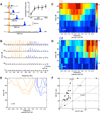Nonoverlapping sets of synapses drive on responses and off responses in auditory cortex
- PMID: 20159453
- PMCID: PMC3800047
- DOI: 10.1016/j.neuron.2010.01.020
Nonoverlapping sets of synapses drive on responses and off responses in auditory cortex
Abstract
Neurons in visual, somatosensory, and auditory cortex can respond to the termination as well as the onset of a sensory stimulus. In auditory cortex, these off responses may underlie the ability of the auditory system to use sound offsets as cues for perceptual grouping. Off responses have been widely proposed to arise from postinhibitory rebound, but this hypothesis has never been directly tested. We used in vivo whole-cell recordings to measure the synaptic inhibition evoked by sound onset. We find that inhibition is invariably transient, indicating that off responses are not caused by postinhibitory rebound in auditory cortical neurons. Instead, on and off responses appear to be driven by distinct sets of synapses, because they have distinct frequency tuning and different excitatory-inhibitory balance. Furthermore, an on-on sequence causes complete forward suppression, whereas an off-on sequence causes no suppression at all. We conclude that on and off responses are driven by largely nonoverlapping sets of synaptic inputs.
Copyright 2010 Elsevier Inc. All rights reserved.
Figures







Similar articles
-
Phasic Off responses of auditory cortex underlie perception of sound duration.Cell Rep. 2021 Apr 20;35(3):109003. doi: 10.1016/j.celrep.2021.109003. Cell Rep. 2021. PMID: 33882311 Free PMC article.
-
Differential Receptive Field Properties of Parvalbumin and Somatostatin Inhibitory Neurons in Mouse Auditory Cortex.Cereb Cortex. 2015 Jul;25(7):1782-91. doi: 10.1093/cercor/bht417. Epub 2014 Jan 14. Cereb Cortex. 2015. PMID: 24425250 Free PMC article.
-
Synaptic mechanisms underlying functional dichotomy between intrinsic-bursting and regular-spiking neurons in auditory cortical layer 5.J Neurosci. 2013 Mar 20;33(12):5326-39. doi: 10.1523/JNEUROSCI.4810-12.2013. J Neurosci. 2013. PMID: 23516297 Free PMC article.
-
When Sound Stops: Offset Responses in the Auditory System.Trends Neurosci. 2018 Oct;41(10):712-728. doi: 10.1016/j.tins.2018.08.009. Epub 2018 Sep 25. Trends Neurosci. 2018. PMID: 30274606 Review.
-
Balance or imbalance: inhibitory circuits for direction selectivity in the auditory system.Cell Mol Life Sci. 2015 May;72(10):1893-906. doi: 10.1007/s00018-015-1841-2. Epub 2015 Feb 1. Cell Mol Life Sci. 2015. PMID: 25638210 Free PMC article. Review.
Cited by
-
Hearing an illusory vowel in noise: suppression of auditory cortical activity.J Neurosci. 2012 Jun 6;32(23):8024-34. doi: 10.1523/JNEUROSCI.0440-12.2012. J Neurosci. 2012. PMID: 22674277 Free PMC article.
-
Remodeling the cortex in memory: Increased use of a learning strategy increases the representational area of relevant acoustic cues.Neurobiol Learn Mem. 2010 Sep;94(2):127-44. doi: 10.1016/j.nlm.2010.04.009. Epub 2010 Apr 29. Neurobiol Learn Mem. 2010. PMID: 20434577 Free PMC article.
-
Listening in complex acoustic scenes.Curr Opin Physiol. 2020 Dec;18:63-72. doi: 10.1016/j.cophys.2020.09.001. Epub 2020 Sep 8. Curr Opin Physiol. 2020. PMID: 33479600 Free PMC article.
-
Primary visual cortex represents the difference between past and present.Cereb Cortex. 2015 Jun;25(6):1427-40. doi: 10.1093/cercor/bht318. Epub 2013 Dec 15. Cereb Cortex. 2015. PMID: 24343889 Free PMC article.
-
Context-dependent signaling of coincident auditory and visual events in primary visual cortex.Elife. 2019 May 23;8:e44006. doi: 10.7554/eLife.44006. Elife. 2019. PMID: 31115334 Free PMC article.
References
-
- Bregman AS. Auditory Scene Analysis: The Perceptual Organization of Sound. Cambridge, MA: MIT Press; 1990.
-
- Bregman AS, Ahad PA, Kim J. Resetting the pitch-analysis system. 2. Role of sudden onsets and offsets in the perception of individual components in a cluster of overlapping tones. J. Acoust. Soc. Am. 1994;96:2694–2703. - PubMed
-
- Brugge JF, Merzenich MM. Responses of neurons in auditory cortex of the macaque monkey to monaural and binaural stimulation. J. Neurophysiol. 1973;36:1138–1158. - PubMed
-
- Calford MB, Webster WR. Auditory representation within principal division of cat medial geniculate body: an electrophysiology study. J. Neurophysiol. 1981;45:1013–1028. - PubMed
MeSH terms
Grants and funding
LinkOut - more resources
Full Text Sources
Other Literature Sources

